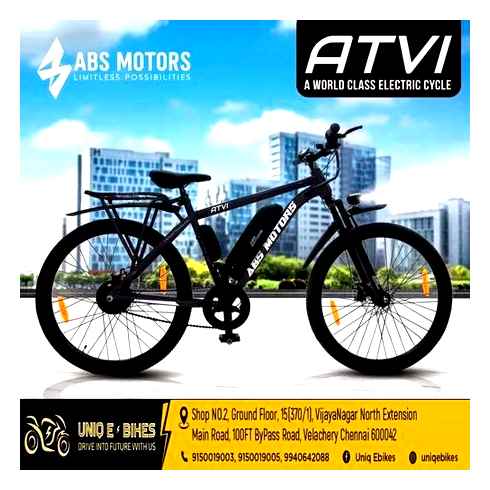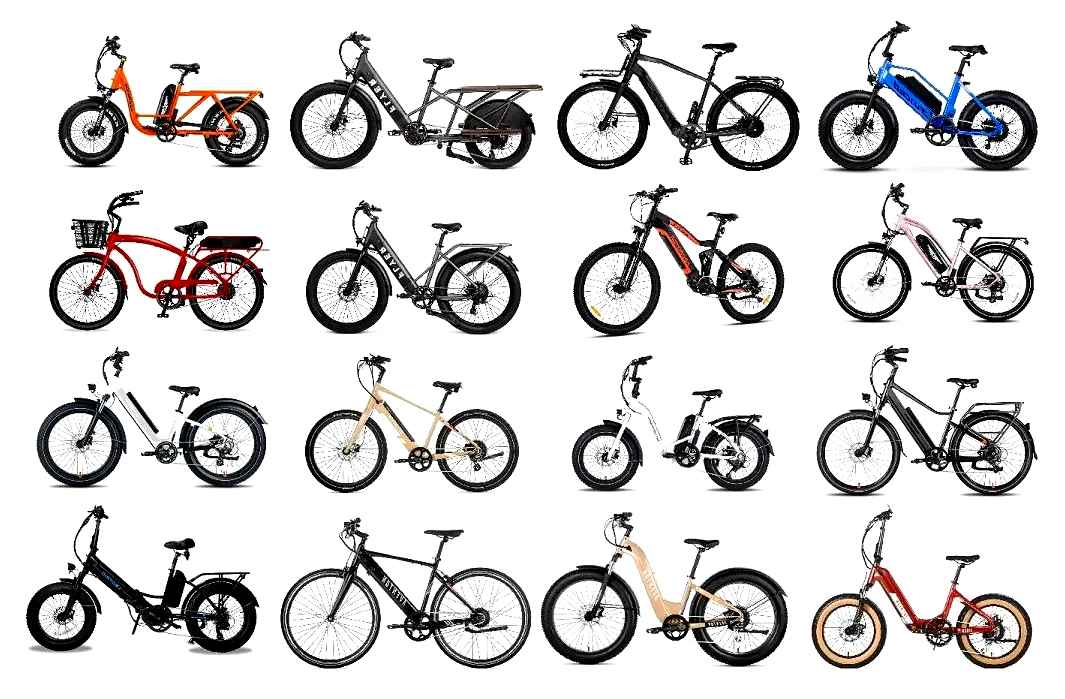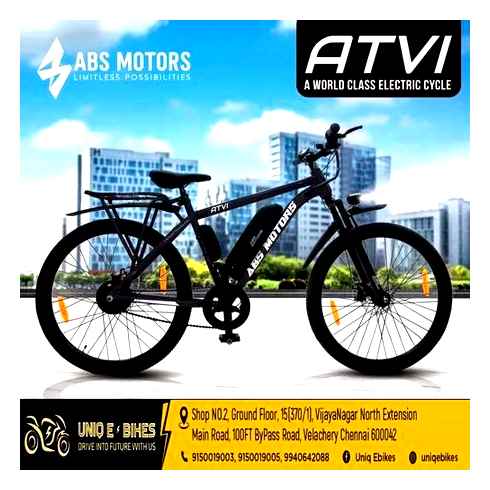Hero Electric Bikes in India
Hero Electric bikes price starts at ₹ 67,190. Hero Electric has a total of 7 bikes of which 2 models are upcoming which include AE-29 and AE-47. The Hero Electric NYX HX is the most expensive bike with a price tag of ₹ 86,540. Select a Hero Electric bike to find out its latest price, specifications, features and more.
Upcoming Hero Electric Bikes
About Hero Electric Bike
Hero Electric entered the electric two-wheeler segment in India in 2008, after 12 years of extensive research in the segment. Hero Electric has gone on to become the market leader in this segment with a strong network of more than 300 exclusive sales and service outlets across the country. Hero Electric had started manufacturing its electric bikes in its state-of-the-art manufacturing facility near Ludhiana in 2007, a few months prior to their launch in 2008.
Hero Electric has many industry firsts to its credit. For example, it is the only Electric Vehicle (EV) manufacturer in India to launch dedicated charging stations featuring an in-house design and development. Hero Electric two wheeler also became the first EV brand in India to launch a one-of-a-kind electric bike door-step service, branded as Electric Bike Assistance (EBA), for its customers across the country.
Hero Electric has also played a crucial role in founding and constituting the Society of Manufacturers of Electric Vehicles (SMEV), a globally representative body of the Indian EV industry comprising of renowned members from the EV industry in India. As of 2018, Hero Electric bike has launched more than 15 electric bike models in the country and has a presence in more than 30 countries.
The range of Hero Electric bike in India consists of the Flash, NYX, Optima Plus, Photon and Cruz which form the company’s 2018 product line-up.
Hero Electric bike in India start at around ₹25,500 for the 2018 Flash and go up to ₹59,900 for the 2018 Cruz. All Hero Electric bike price listings can be found on the website of autoX.
Hero Lectro E-Cycle Range Explained
Cycling is something that is not really enjoyed by everyone. For many people, it is a tedious activity that requires a lot of physical effort. What if we tell you that there is a certain type of cycle that can motivate you to ride longer distances? Well, Hero cycles have an answer for you. In this article, we will explain to you the Hero Lectro E-Cycle range and help you decide which suits you the best.
Hero Lectro range of electric cycles or E-Cycles is a fusion between regular cycles and electric scooters. What it offers is the convenience of an electric scooter while offering all the goodness of a regular bicycle. The range of Hero Lectro comes with an electric that powers the rear wheel of the cycle. The electric motor is mounted directly on the rear hub of the cycle avoiding any power loss. Also, you do not require a driving license to ride these e-cycles on the public roads.
Types of Hero Lectro E-Cycles
There are a total of 12 models on sale in the market. The base models or the entry-level models offer single speed gears. While the mid-range models offer multiple-speed set-up. This allows for easy riding and less effort. Some of the models also offer Bluetooth app and RFID lock for increased security.
Also read. A Guide to buying bicycles. Online or Offline
For riding in various situations, some of the bikes also offer integrated headlamp and tail lamps. The top of the line model offers various sensors, display and switches and also a riding range of 80 km.
The Hero Lectro E-Cycle range begins from C3 26-inch SS which is the base variant that gets four different riding modes. It has a maximum speed of 25 km/h on battery and a range of 25 km on a full charge. Mid-range model Hero Lectro C8 700C 7S offers 7-speed gear from Shimano. Other features include front and rear suspension and disc brake on both wheels. The top-end Hero Lectro EHX20 offers torque sensors, speed sensor, crank sensor and a central power unit. It offers 80km riding range but the price is similar to an entry-level KTM bike.
Price of Hero Lectro range
The four base models of the Hero Lectro range. C3 26-inch SS, C4 26-inch SS, C5 27.5-inch SS and C6 700C SS are priced at Rs 24,999. The next two models. Clix SS and Kinza SS are priced at Rs 28,999. The 7-Speed models. Clix 7S and Kinza 7S are priced at Rs 31,000. While the single-speed CSi 26-inch with gadgets like Bluetooth app, RFID Smart lock and integrated headlamps and tail lamp costs Rs 32,499. The 7-speed Lectro C8 700C 7S with front suspension costs the same. The top model Lectro EHX20 with triple sensor system, display and switches, and range of 80 km on a full charge costs Rs 1.35 lakh! It is the most expensive model in the line-up.
Why buy Hero Lectro?
You can order them from the comfort of your home and that’s the biggest advantage during this pandemic. It is extremely affordable to own and ride as only 0.25 units of electricity are needed to charge it completely. Apart from the top-end model, all the other versions are powered by a 250-watt motor and the battery takes about 3-4 hours to charge completely. You can ride it like a regular bicycle and there is no need of driving license too. Since these are electric bikes, there is no maintenance too!
E cycles are not only easy to ride but also are fairly affordable considering the cost of the entry-level models. Apart from helping us maintain our fitness, such cycles can go a long way in reducing our carbon footprint. In fact, E Cycles can actually replace our conventionally powered vehicles for running our daily errands.
Let us know in the Комментарии и мнения владельцев section if you would go and get one of the e-cycles from the Hero Lectro range. Also do join our exclusive 91Wheels Telegram group where we bring you the latest updates from the Indian Automotive Industry.
Battery
Your e-bike’s battery is vital for supplying power to the bike’s motor. Here are a few of the factors you might want to consider when comparing the batteries on different bikes.
Internal Versus External Batteries
While some e-bikes still have batteries that are housed outside of the frame, more and more modern e-bikes have batteries that fit seamlessly into the frame of the bike.
External batteries are more obvious, but they’re easier to access and much easier to replace with third-party options. Internal batteries, on the other hand, are practically invisible, but you’ll probably want to stick with first-party options if you need an additional battery.
How To Tell Which E-Bike Battery Is Bigger?
If you’re looking for how big a battery’s capacity is, look for the amp-hour or watt-hour numbers. A battery with twice as many amp-hours of power has twice as much juice as a battery with half as many amp-hours.
Different companies use different measures, however, so you may need to convert between the two metrics. To get watt-hours, multiply amp-hours by voltage. To get amp-hours, divide watt-hours by voltage.
In general, a battery with more capacity will offer more range – but it will also be heavier.
Remember that you can always buy a second battery, charge both, and carry the spare with you. This is especially helpful for touring and commuting since you’ll probably be carrying some cargo already.
Charging Considerations
E-bike batteries are almost always very standard lithium batteries in bike-friendly form factors. If charging speed is a big concern, you’ll probably want a fast charger, not a special battery.
Most modern e-bike batteries can be charged while on or off of the bicycle, but if on-bike charging is especially important, be sure to verify that the bike you’re looking at has a charging port.
Comparing Numbers Across Bike Types
A big, heavy bike that gets 30 miles per charge is very different from a light, efficient bike that gets 30 miles per charge. On the first bike, you’re less able to extend the range of your bike via human effort.
Running out of power mid-ride will also feel pretty bad. On the second bike, a little bit of effort will massively increase your range, and you might turn off the motor entirely on flat ground, even if you have lots of battery remaining.
This means that you should be careful when comparing e-bike statistics in a vacuum. Try to maintain a holistic view of the bike and put each metric in context. A bike with “worse” metrics might wind up being better for your use case than one with “better” numbers.
Bike Types / Riding Styles
There are a lot of different kinds of bikes out there. For just about any type of bike you can think of, you can find at least a few e-bikes of that type.
You’ll find terrifyingly light road bikes, powerful, rugged mountain bikes, long-range touring bikes, and useful commuters and city bikes. You’ll also find lots of cruisers, adventure bikes, and other options that are designed to let you have fun and tackle any terrain.
Here’s a quick overview of some of the more common bike types and who they’re designed for:
Road Bikes
These are very light bikes with skinny tires that favor aggressive riding styles. They’re designed for speed and exercise, not for transportation and utility.
Hybrid / City / Commuter Bikes
These three categories are all very similar. They’re bikes that are designed as effective transportation options for city dwellers.
This means that they’re fast and efficient to pedal without sacrificing utility. Expect road-style tires, cargo options, and a more upright riding position than road bikes.
Mountain Bikes
These bikes are designed for off-road riding, often on treacherous trails. Expect big knobby tires, suspension, and maybe even a seat that can slide down at the push of a button.
Cruisers
Cruisers traditionally have high swept-back handlebars and a relaxed, upright riding position. They’re designed for slower, casual rides, allowing you to simply enjoy yourself as you go.

Adventure Bikes
Bikes that are perfect for trips and outings. These aren’t mountain bikes in the classic sense but are instead perfect for riding on less treacherous dirt trails – or big stretches of wilderness. Think exploration, not big drops.
Touring Bikes
Touring bikes are designed to be ridden for hours at a time for days on end. They come with dependable, rugged parts, cargo-carrying options, and lots of low gears for tired riders.
Touring bikes usually make great commuter bikes, but the reverse isn’t always true – your city bike might not like riding on dirt roads for four or five hours, but your touring bike will feel right at home.
Cargo Bikes
These bikes are set up to pull trailers or carry heavy objects. They tend to have sturdy frames, powerful motors, and lots of gears. You’ll generally find more cargo-carrying options on cargo bikes than on other bikes, but this isn’t always the case.
Riding Styles
When we talk about bike “riding styles,” we’re talking about how you sit on the bicycle. Cruisers, for example, have high handlebars and low seats. This means that the rider will sit totally upright.
Road bikes, on the other hand, have very high seats and low handlebars. This means that the rider will need to bend over to ride the bicycle.
In general, if you want to stay seated while pedaling hard, you’ll probably want a bike on the more aggressive side of things. If you want to relax while you’re riding, however, you’ll want a bike with a less aggressive riding position.
Your personal preference should be the biggest factor when considering different riding styles. Go for what you’re used to. If you’ve spent a lot of time riding cruisers, you’ll probably want to choose a city bike with a particularly relaxed riding position.
If you’re used to riding road bikes, on the other hand, you might want a commuter with lower handlebars and a seat that’s farther back. In the below articles, you might be able to find inspiration to find out what type of electric bike exactly you are looking for:
Tires and Weight
Your bike’s tires are generally determined by which type of bike you choose.
A city bike, for example, will have tires that are designed for riding on pavement. An adventure or mountain bike will have knobby tires that are designed for off-roading.
In general, as long as the type of tires on your bike match up with the use case you’re intending, you’ll be fine.
So why don’t all bikes have big fat tires for better grip? The answer is drag. The wider and knobbier your tire is, the more rolling resistance it causes. Fat tire e-bikes are less efficient to pedal and take more motor power than bikes with skinny road tires.
This means that it’s generally better to go with the skinniest, smoothest tires you can get away with for your intended use case. Planning to mostly commute with some light dirt riding on the weekend? Hybrid tires are totally fine.
It is worth briefly noting that it’s a big pain to change tires on bikes with hub motors. Because of this, e-bike tires are generally much thicker and more resilient than normal bike tires. Expect fewer flats – but also expect to need more time and tools when you do get one.
Does Weight Matter?
E-bikes can get pretty heavy. The lightest e-bikes tend to be about 10 pounds heavier than conventional bikes in the same style. Heavy e-bikes range from 70 to 100 pounds.
While your bike’s motor means that it’ll stay easy to pedal at any weight, a heavy bike will still feel heavy. It’ll feel less like a nimble bike and more like a motorcycle. It’ll also make the bike more awkward to carry up stairs or maneuver through doors.
On the flip side, more weight means that the bike can have a much bigger motor and battery. Heavy bikes often have huge motors and batteries, giving them maximum ranges of 60 miles per charge – or more.
If you’re less concerned with feel and more concerned with range, the weight might not be a big downside.
- Do you want to do a lot of riding with the motor off, or on low pedal assist levels? Look for a lighter bike, but be aware that you might wind up with less range or a less powerful motor.
- Do you need lots of range and plan to use the motor a lot? Be willing to accept a heavier bike in order to meet your other needs.
Cadence and Torque Sensors
Most e-bikes have a pedal assist mode. When this is activated, your e-bike’s motor helps you out as you pedal. Your e-bike detects when you’re pedaling in one of two ways: with a cadence sensor or with a torque sensor.
A cadence sensor simply detects when your pedals are spinning. This is usually achieved via a ring of magnets. Cadence sensors can’t tell how much force you’re applying to the pedals. It also usually takes a couple of pedal revolutions before your bike figures out that you’re pedaling.
On the flip side, cadence sensors always know if you’re pedaling, so it doesn’t matter how much effort you’re using or what gear you’re in.
A torque sensor, on the other hand, detects how much power you’re putting into your pedals. This has two big advantages: it detects the instant you start to pedal, and it means that your bike can modulate its power output to match yours. The harder you pedal, the more effort your bike’s motor will put in.
The downside here is that torque sensors struggle to detect you pedaling at low levels of effort. If you’re cruising along at a relaxed pace, your bike might think you’ve stopped pedaling entirely and shut off the motor.
This is very much a personal preference thing, so if you can, try out a few models with both types of sensors. For me, torque sensors generally feel more responsive and fun to ride than cadence sensors.
Torque sensors are more complicated and expensive, however, and the difference is minor enough that sensor type is pretty far down my list of things to consider when buying an e-bike.
Hero Edition Models
The young rider bikes, sharpened and clarified.
TRIAL Hero
Peak performance, razor sharp skills
The KUBERG TRIAL. Maximized. Stand up and take on the world. Engineered to glide over anything you can throw at it, this is the groundbreaking, no compromise mini trials bike.
33 kg 27 kmh 5. 12 Years 6 h Charging 2 h Riding
CROSS Hero
Really rugged, true freedom

The proven, rugged, hard wearing, fun machine, sharpened and clarified. Performance parts from the ground up, developed by dedicated technicians and professional riders, this is the KUBERG CROSS with endless possibilities. The very best a young rider can get.
33 kg 27 kmh 6. 12 Years 6 h Charging 2 h Riding

Play video 0:20
